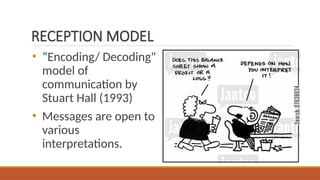mediaandinformationliteracycommunication-pptx.pptx
- 1. Introduction to Media and Information Literacy (Part 1) Mr. Arniel Ping St. StephenŌĆÖs High School Manila, Philippines Communication Models Media Literacy Information Literacy Technology (Digital) Literacy MIL PPT 01, Updated: October 26, 2016 MEDIA AND INFORMATION LITERACY (MIL)
- 2. Learning Competencies The learners will be able toŌĆ” ’é¦ describe the nature of communication and the concepts related to it (SSHS); ’é¦ describe how communication is affected by media and information (MIL11/12IMIL-IIIa-1); and ’é¦ identify the similarities and differences of media literacy, information literacy, and technology literacy (MIL11/12IMIL-IIIa-2).
- 3. Topic Outline I- Introduction to Media and Information Literacy A- Communication 1. Definitions 2. Communication Models B. How Media and Information Affect Communication C. Media Literacy, Information Literacy, and Technology Literacy
- 4. FORMATIVE ASSESSMENT: RECITATION ŌĆó What is communication? ŌĆó How do we communicate? ŌĆó Why do we communicate?
- 5. Communication the act or process of using words, sounds, signs, or behaviors to express or exchange information or to express your ideas, thoughts, feelings, etc., to someone else (http://www.merriam-webster.com) the exchange of information and the expression of feeling that can result in understanding (http://dictionary.cambridge.org)
- 6. VERBAL AND NON-VERBAL COMMUNICATION Verbal Communication- an interaction in which words are used to relay a message through speech or with the use of voice. Non-verbal Communication- an interaction where behavior is used to convey and represent meanings.
- 7. Information- processed data and/or knowledge derived experiences, instruction, signals or symbols. Media- channels or ways we used to transmit or communicate messages; communication tools. Technology- application of scientific knowledge to the practical aims of human life or to change and manipulate the human environment.
- 8. TRANSMISSION MODELS Who COMMUNICATOR Says What MESSAGE In Which Channel MEDIUM To Whom RECEIVER With what effect? EFFECT LasswellŌĆÖs Communication Model (1948)
- 9. Identify the following: ’é¦Communicator/ Sender? ’é¦Message? ’é¦Medium/ Channel? ’é¦Receiver? ’é¦Effect?
- 10. TRANSMISSION MODELS Shannon-WeaverŌĆÖs Communication Model (1948)
- 11. TRANSMISSION MODELS Westley and MacLeanŌĆÖs Model of Communication (1957) ŌĆó Event or Information (X1, X2, X3 and X4ŌĆ”Xn) ŌĆó Feedback (f) ŌĆó Advocate (A) ŌĆó Channel (C) ŌĆó Audience (B)
- 12. TRANSMISSION MODELS GerbnerŌĆÖs Model of Communication (1956)
- 13. RITUAL OR EXPRESSIVE MODEL ŌĆó Communication as a Culture (1985) by James William Carey ŌĆó views communication as "a representation of shared beliefs" ŌĆó communication is defined as "a symbolic process whereby reality is produced, maintained, repaired, and transformed"
- 14. PUBLICITY MODEL ŌĆó communication as display and attention ŌĆó audience as ŌĆ£spectatorsŌĆØ rather than participants or information receivers
- 15. RECEPTION MODEL ŌĆó ŌĆ£Encoding/ Decoding" model of communication by Stuart Hall (1993) ŌĆó Messages are open to various interpretations.
- 16. RECEPTION MODEL Osgood- Schramm Model Of Communication (1954)
- 17. RECEPTION MODEL BerloŌĆÖs SMCR Model of Communication (1960)
- 18. What have you learned about communication after studying the different models? SENDER MESSAGE MEDIUM RECEIVER EFFECT
- 19. How is communication affected by media and information? INFORMATION ’é¦ data, knowledge derived from study, experience, or instruction, signals or symbols ’é¦ knowledge of specific events or situations MEDIA ’é¦ Communication Tools
- 20. FORMATIVE ASSESSMENT: RECITATION ’āś How does Facebook serve as a tool for communication? ’āś How does Facebook affected how people communicate with each other? ’āś How does Facebook affected the quantity and quality of information available to people?
- 21. MEDIA LITERACY, INFORMATION LITERACY, AND TECHNOLOGY (DIGITAL) LITERACY MEDIA RECEIVE INFORMATION DIGITAL TRADITIONAL SHARE INFORMATION LOOK FOR INFORMATION RECEIVE INFORMATION LOOK FOR INFORMATION SHARE INFORMATION
- 22. ŌĆó The ability to read, analyze, evaluate and produce communication in a variety of media forms. Media Literacy ŌĆó The ability to recognize when information is needed and to locate, evaluate, effectively use and communicate information in its various formats. Information Literacy ŌĆó The ability to use digital technology, communication tools or networks to locate, evaluate, use, and create information. Technology (Digital) Literacy MEDIA AND INFORMATION LITERACY (MIL)
- 23. MEDIA AND INFORMATION LITERACY (MIL)
- 24. VIDEO PRESENTATION Introduction to Media and Information Literacy YouTube Channel: Arniel Ping Retrieved October 26, 2016 from https://www.youtube.com/watch?v=b-Y6LRIppU4
- 25. REFERENCES ’é¦ Media and Information Literacy Curriculum Guide by DepEd ’é¦ Media and Information Literacy by Boots C. Liquigan, Diwa Learning Systems Inc. ’é¦ UNESCO Media and Information Literacy Curriculum for Teachers ’é¦ http://faculty.georgetown.edu/irvinem/CCTP748/Carey-summary-com m-culture.html ’é¦ http://juliemartin.org/juliemartin-audiencesreception.pdf ’é¦ http://communicationtheory.org/category/communication-models/pa ge/2/
Editor's Notes
- #16: Osgood- Schramm Model Of Communication Communication is a two way process where both sender and receiver take turns to send and receive a message. The message is only sent after encoding so the sender is also called Encoder and the encoded message is decoded under receipt by the receiver, making him the Decoder.
- #21: Explain this illustration. Looking at this illustration, How do you understand media literacy? How do you understand information literacy? How do you understand digital literacy?
- #22: What are the similarities and differences of media literacy, information literacy, and technology literacy? Media literacy, information literacy, and technology literacy are combined together as Media and Information Literacy (MIL)
























